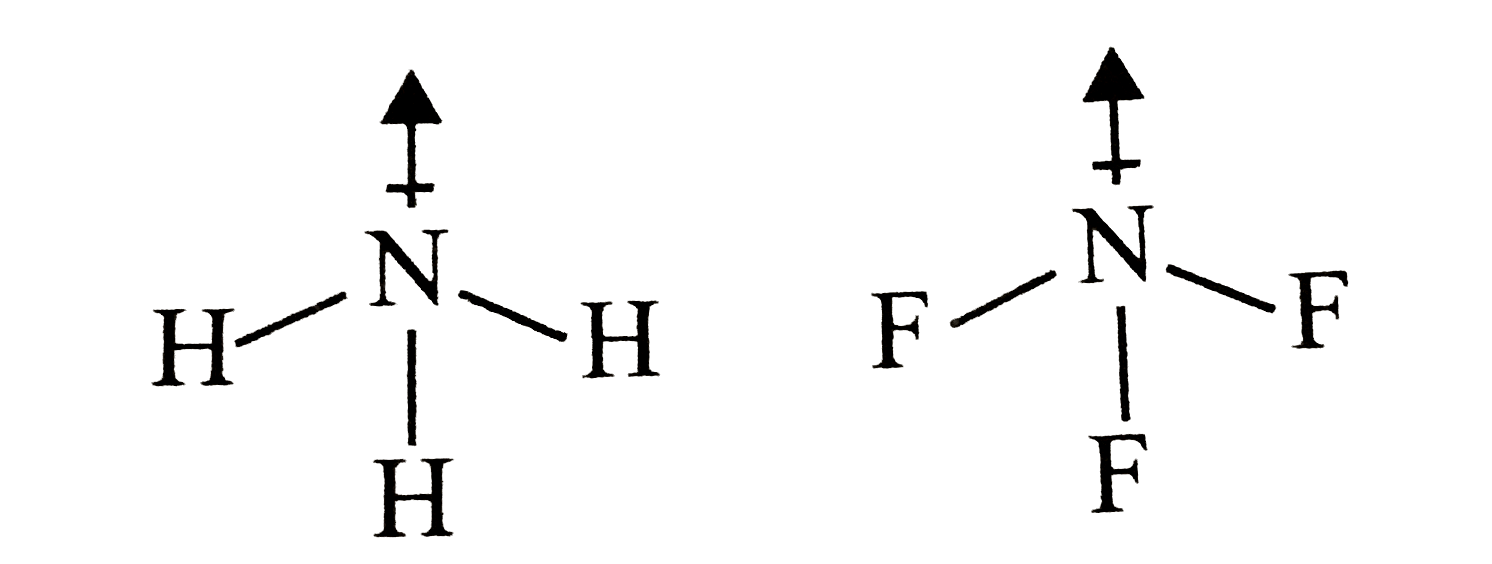Fluorine is more electronegative than either boron or phosphorous. What conclusion can be drawn from the fact that BF3 has no dipole moment but PF3 does
BF3 is not spherically symmetrical but PF3 is
BF3 molecule must be linear
The atomic radius of P is larger than the atomic radius of B
The BF3 molecule must be planar triangular
The correct Answer is:D
Step by step video & image solution for Fluorine is more electronegative than either boron or phosphorous. What conclusion can be drawn from the fact that BF_(3) has no dipole moment but PF_(3) does by Chemistry experts to help you in doubts & scoring excellent marks in Class 12 exams.
Updated on:21/07/2023Similar Questions
Although F is more electronegative than H, the resultant dipole moment of NH3 is much more than that of NF3. It can be explained as

View SolutionAccount for the following observations
(a) AlCl3 is a Lewis acid
(b) Though fluorine is more electronegative than chlorine yet BF3 is a weaker Lewis acid than BCI3
(c) PbO2 is a stronger oxidising agent than SnO2
(d) The +1 oxidation state of thallium is more stable than its +3 state.
View SolutionWhat inferences would you derive from the following observations?
dipole moment of BF3 is zero.
View SolutionAssertion (A): I2 can displace Cl2 form NaClO3.
Reason (R ): I is more electronegative than CI.
If both (A) and (R) are correct, and (R) is the correct explanation of (A)
If both (A) and (R) are correct, but (R) is not the correct explanation of (A).
If (A) is correct, but (R) is incorrect.
If (A) is incorrect, but (R) is correct.
View SolutionStatement-1: Ethyne is more reactive than ethene towards hydrogenation
Statement-2: H2 in presence of Lindlar catalyst is more reactive than H2 with Pd in hydrogenation reaction
Statement-3: Dipole moment of o-xylene is greater than m-xylene
View SolutionNitrogen , oxygen and fluorine are the highly electronegative elements. When they are tied to a hydrogen atom to form covalent bond, the electrons of the covalent bond are shifted towards the more electronegative atom.This partially positively charged hydrogen atom forms a bond with the other electronegative atom. This bond is called as hydrogen bond and is weaker than covalent bond.For example, in HF molecule, the hydrogen bond exists between hydrogen atom of one molecule and fluorine atom of another molecule as depicted
−−−Hδ+−Fδ−−−−Hδ+−Fδ−−−−Hδ+−Fδ−
Here, hydrogen bond acts as bridge between atoms which holds one atom by covalent bond and the other by hydrogen bond.Hydrogen bond is represented by a dotted line (---) while a solid line represents the covalent bond. Thus, hydrogen bond can be defined as the attractive force which binds hydrogen atom of one molecule with the electronegative atom (F,O and N) of another molecule.
What would be correct about bonding in chloral hydrate CCl3CH(OH)2?
View SolutionNitrogen , oxygen and fluorine are the highly electronegative elements. When they are tied to a hydrogen atom to form covalent bond, the electrons of the covalent bond are shifted towards the more electronegative atom.This partially positively charged hydrogen atom forms a bond with the other electronegative atom. This bond is called as hydrogen bond and is weaker than covalent bond.For example, in HF molecule, the hydrogen bond exists between hydrogen atom of one molecule and fluorine atom of another molecule as depicted
−−−Hδ+−Fδ−−−−Hδ+−Fδ−−−−Hδ+−Fδ−
Here, hydrogen bond acts as bridge between atoms which holds one atom by covalent bond and the other by hydrogen bond.Hydrogen bond is represented by a dotted line (---) while a solid line represents the covalent bond. Thus, hydrogen bond can be defined as the attractive force which binds hydrogen atom of one molecule with the electronegative atom (F,O and N) of another molecule.
What statement is incorrect about D2O (solid)
View SolutionPolar covalent molecules exhibit dipole moment. Dipole moment is equal to the product of charge separation , q and the bond length d for the bond. Unit of dipole moment is debye. One debye is equal to 10−18 esu cm.
Dipole moments is a vector quantity. It has both magnitude and direction. Hence, dipole moment of a molecule depends upon the relative orientation of the bond dipoles, but not on the polarity of bonds alone. A symmetrical structure shows zero dipole moment. Thus, dipole moment helps to predict the geometry of a molecules. Dipole moment values can be distinguish between cis- and trans- isomers, ortho, meta and pare-forms of a substance, etc.
Q. A diatomic molecule has a dipole moment of 1.2D. If the bond length is 1.0×10−8 cm, what fraction of charge does exist each atom?
View SolutionA box contains 4 white and 3 black balls. Another box contains 3 white and 4 black balls. A die is thrown. If it exhibits a number greater than 3, the ball is drawn from the first box. Otherwise, a ball is drawn from the second box. A ball drawn is found to be black. The probability that it has been drawn from the second box is
View SolutionA compass needle made of pure iron (with density 8000kg/m3) has a length 5 cm, width 1.0 mm and thickness 0.50 mm. The magnitude of magnetic dipole moment of an iron is μFe=2×10−23 J/T. If magnetisation of needle is equivalent to the alignment of 10% of the atoms in the needle, what is the magnitude of the neddle's magnetic dipole moment μ ? (mass of iron per mole =0.05kg/mole,NA=6×1023)
View Solution
